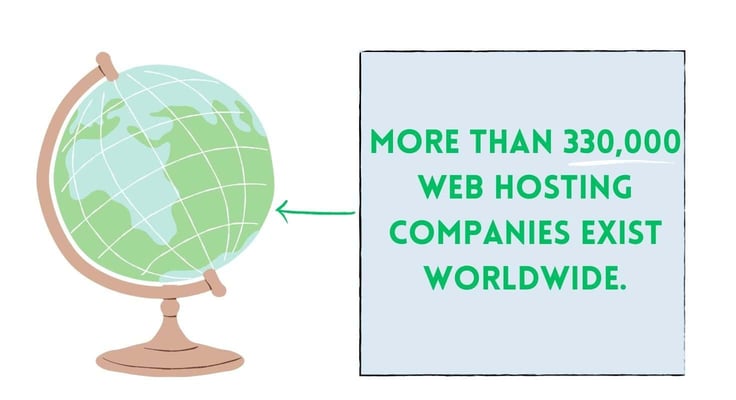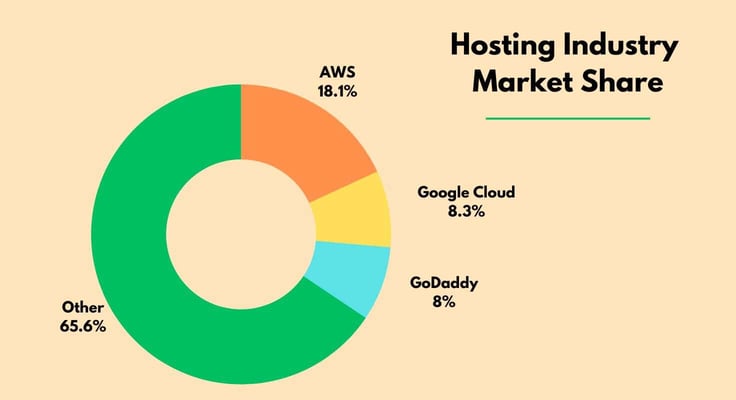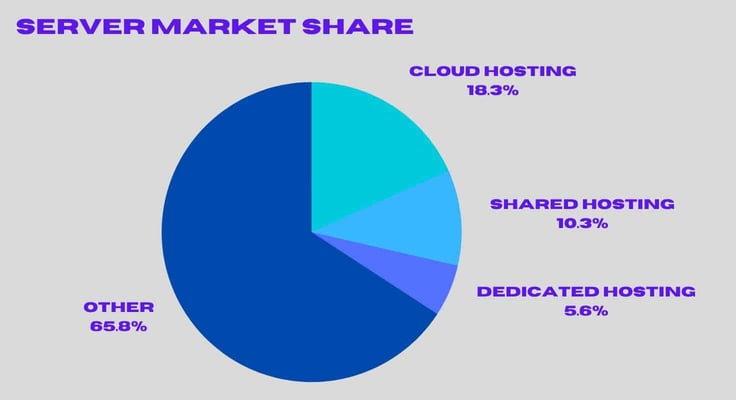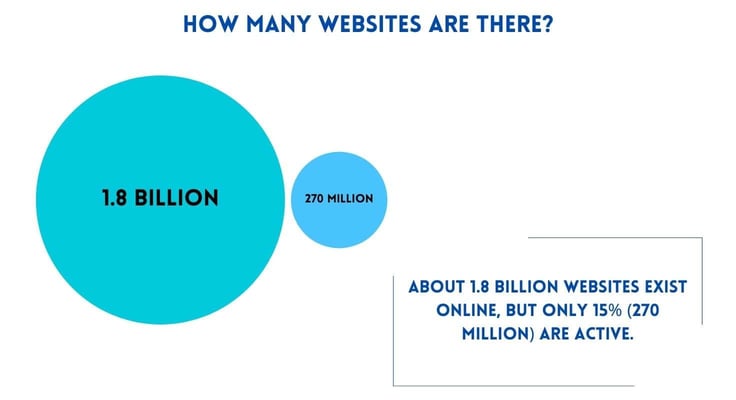
The year was 1994 when the first version of the SSL protocol saw the light of day. It was a rough ride from the start due to various security vulnerabilities, so much so that the protocol was replaced by Transport Layer Security (TLS) in 1999. Here’s the kicker: most people continue to refer to it as SSL, which is why we still have SSL certificates, although they’re technically TLS.
The advent of SSL was just one of many events that shaped the world of web hosting we know today. The result is a vast ocean of domain and hosting providers that help web owners from all over the world get a piece of the ever-growing online landscape. From market share data to information on specific providers, these web hosting stats will provide you with a better understanding of what is going on in the web hosting space.
1. There Are More Than 330,000 Web Hosting Companies Worldwide
If you google how many web hosting companies there are, you’ll get a few different answers. However, the consensus is that there are more than 330,000 web hosting companies across the globe, though the exact number is unknown1.

Taking into account that this information is based on data that is a few years old, it’s very likely that today’s number is considerably higher due to the web’s expansion.
2. The 3 Largest Web Hosting Companies are AWS (18%), Google Cloud (8%), and GoDaddy (8%)
The three largest hosting companies are AWS, Google Cloud, and GoDaddy in that order2. And these hosting giants each rake in millions in annual revenue. Revenue in the whole web hosting market is projected to reach a whopping $124.8 billion in 20233. By 2028, revenue is expected to almost triple and reach $345 billion.
Three companies hold more than one-third of the global market share and, as such, are the critical drivers of projected growth.

AWS: 18.11% Market Share
Considering it offers a wide array of cloud services, from basic hosting and deployment to analytics, machine learning, and more, it’s no surprise that AWS has the largest market share among web hosting companies. With its comprehensive package that combines numerous services and tools, AWS is perceived as the go-to, one-stop solution for many.

Stats about AWS
- Close to 50 million live websites use AWS as their hosting provider2
- Out of the top 1 million websites, 238,598 or 23.86% employ AWS5
- Some of the biggest brands in the world are AWS customers, including Netflix, Reddit, BBC, Bloomberg, Yahoo, and many others
It’s evident that high-traffic sites favor Amazon’s subsidiary, likely due to its widespread network of data centers that ultimately facilitate less latency and a fine-tuned experience on which the end-users can rely at any moment.
Google Cloud: 8.27% Market Share
A massive network of servers, industry-grade products and services, as well as robust privacy, compliance, and security standards, make Google Cloud one of the best web hosting providers available. Thanks to its global backbone, the tech titan is able to provide quite a bit of flexibility for load-balancing, all the while reducing end-user latency.

Stats about Google Cloud
- Slightly more than 54 million live websites are using Google Cloud2
- Out of the top 1 million websites, 86,394 or 8.64% use Google Cloud5
- Sites using it include Twitter, Spotify, Forbes, Vimeo, Washington Post, and plenty of others
The web hosting service has steadily grown since its launch in 2008. As it continues to expand to new regions, expect to see Google Cloud’s market share grow exponentially.
GoDaddy: 8.02% Market Share
Ever since it stepped onto the web hosting scene in 1997, GoDaddy has been building an impeccable reputation at a highly successful rate. The company offers a one-stop solution for domain registration, hosting, and website building, making it an excellent choice for a broad spectrum of users: beginners, developers, and entrepreneurs.
Arguably, two main reasons for its popularity lie in the unusually low cost of shared hosting services and longevity in the domain hosting industry.

Stats about GoDaddy
- Almost 17 million live websites use GoDaddy2
- Out of the top 1 million websites, 20,583 or 2.06% are leveraging GoDaddy5
- Some of its notable clients include Honda, Footlocker, USA Today, Wall Street Journal, and Allianz, to name a few
GoDaddy is also known as the most popular domain registrar, with around 84 million domains attached to its name6. To show you how dominant the company is in this regard, Namecheap is next on the list with a “mere” 16.5 million domains.
Web hosting companies have been around as long as the World Wide Web itself. With decades of experience under their respective belts, these three hosts have established themselves as highly respected global powerhouses. Along with their peers, they have also pushed the boundaries of hosting websites and applications in the last decade or so.
3. Cloud Hosting (18.3%) Is the Most Popular Type of Hosting
The world of web hosting is replete with options that will get your website or app online, each catering to the different needs of website owners. Still, cloud hosting stands apart as the prominent method of bringing digital assets to the web, making up 18.3% of the market7.

Cloud Hosting: 18.3% Market Share
Amid the COVID-19 pandemic, cloud hosting gained popularity due to its greater scalability and flexibility to quickly make changes compared to its counterparts. By the end of 2023, worldwide end-user spending on public cloud services is forecast to grow 21.7% to a total of $597.3 billion8. Revenue is expected to show an annual growth rate of 13.81%, resulting in a market volume of $881.80 billion by 20279.
By pooling computing resources from virtual and physical servers, cloud hosting has the advantages of better security, the ability to manage huge amounts of data, and being a more robust and reliable hosting option than, say, web hosting.
It also helps that in the majority of cases, pay-as-you-go is the prevalent pricing model, meaning you pay for what you use and don’t have to worry about overspending or underspending.
Shared Hosting: 10.3% Market Share
Often labeled as entry-level web hosting, shared hosting is a common choice for many individuals and small businesses with low-traffic websites. As such, it’s projected to reach $72.2 billion by the end of 202710.
Under a shared hosting plan, a single server is shared among multiple users, which means that resources like RAM and CPU are distributed across several websites.
Still, because all resources are shared, the price tag is fairly low, making shared hosting a great option for newbie website owners.
Dedicated Hosting: 5.6% Market Share
Dedicated hosting makes up the smallest fraction of the market share at 5.6%7. Unlike shared hosting, dedicated hosting offers exclusive access to one or more servers. The result is improved performance, enhanced security, and complete control that allows diverse customization options.
Dedicated hosting is an ideal solution for businesses with high-traffic websites and those that require top-of-the-line performance. In addition, those looking to host resource-intensive applications or want to meet particular compliance requirements will also bode well with dedicated hosting.
In the coming years, the demand is expected to increase with the expansion of the IT and telco sectors at a rate of 11.1% until 202710.
4. There Are 1.8 Billion Websites in the World
Even though the exact number keeps changing every day, I have it on good authority that there are 1.8 billion sites online, give or take a few hundred or thousand (it’s a rapidly shifting scene out there)11. Nevertheless, it’s worth noting that only a tiny part of these are continually used and updated, as approximately 15% of sites are active, while the rest are not.

When it comes to engines powering all these sites, WordPress reigns supreme. Around 810 million websites use WordPress, which represents around 43% of all websites1. In other words — well over one-third of the entire internet runs on WordPress. Furthermore, the no-code, open-source content management solution controls 63% of the CMS market share1.
Fun fact: Roughly 71% of businesses have a website these days, largely driven by the ongoing shift to cloud and code-free website builders1. If your business is among the remaining 29%, this is as good a sign as any to start working on your web presence ASAP.
The Internet Is Not Slowing Down
It’s difficult to quantify how important web hosting is for any business, let alone one that is up-and-coming. The era of tech-based convenience and online shopping we live in means that many businesses have to rely on a strong and memorable online presence in order to reach their target audience.
Yet, picking out good hosting for your site is far from an easy task. With seemingly countless providers offering enticing services at varying price ranges, you have your work cut out due to the sheer magnitude of choice.
With the help of these web hosting statistics, I hope you got a better picture of what the situation is like when it comes to hosting providers and that you can subsequently leverage it in some way to stay ahead of your competitors.
Sources and Further Reading
1. https://www.ssldragon.com/blog/web-hosting-trends/#:~:text=2017%20%E2%80%93%20The%20number%20of%20global,is%20in%20our%20daily%20lives.
2. https://www.datanyze.com/market-share/web-hosting–22/
3. https://www.statista.com/outlook/tmo/it-services/it-outsourcing/web-hosting/worldwide
4. https://trends.builtwith.com/websitelist/Amazon
5. https://trends.builtwith.com/hosting
6. https://www.websitebuilderexpert.com/web-hosting/web-hosting-statistics/
7. https://financesonline.com/30-essential-web-hosting-statistics-2019-analysis-of-trends-data-and-market-share/
8. https://www.gartner.com/en/newsroom/press-releases/2023-04-19-gartner-forecasts-worldwide-public-cloud-end-user-spending-to-reach-nearly-600-billion-in-2023
9. https://www.statista.com/outlook/tmo/public-cloud/worldwide
10. https://www.businesswire.com/news/home/20221104005409/en/Web-Hosting-Services-Global-Market-Report-2022-Green-Web-Hosting-Gains-Traction-and-Presents-Opportunities—ResearchAndMarkets.com
11. https://webtribunal.net/blog/how-many-websites/#gref
12. https://colorlib.com/wp/wordpress-statistics/#:~:text=Around%20810%20million%20websites%20use,platforms%20like%20Shopify%20and%20Squarespace.
13. https://w3techs.com/technologies/details/cm-wordpress
14. https://topdesignfirms.com/web-design/blog/online-presence-management







